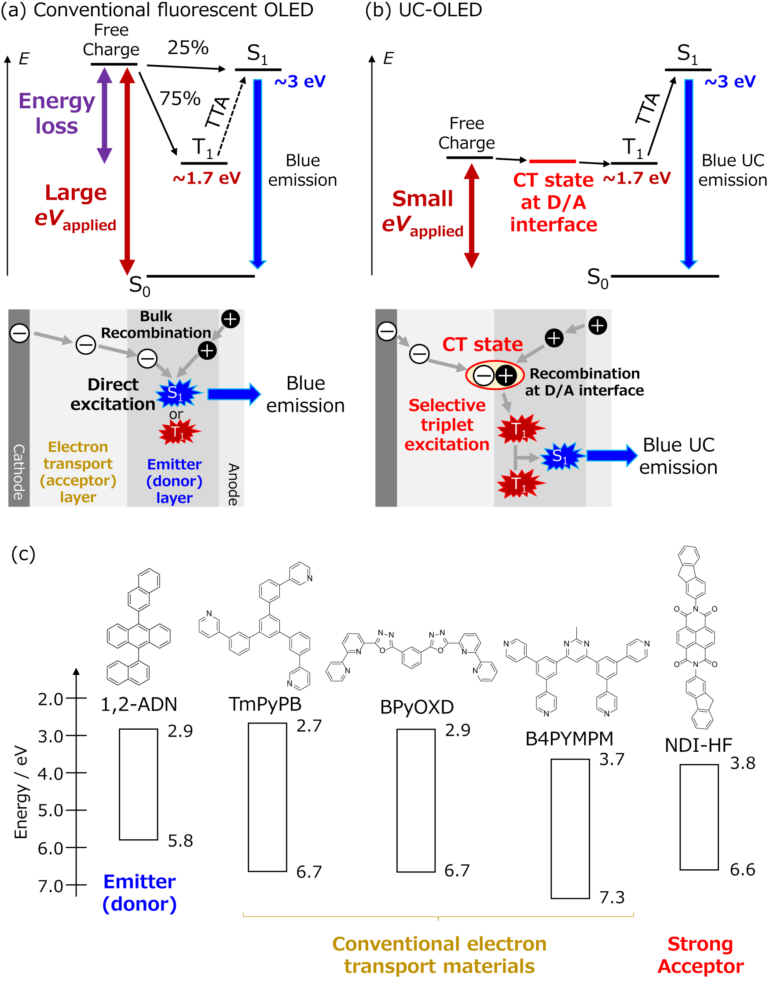Lights could soon use the full color suite of perfectly efficient organic light-emitting diodes, or OLEDs, that last tens of thousands of hours, thanks to an innovation from physicists and engineers at the University of Michigan.
The U-M team’s new phosphorescent OLEDs, commonly referred to as PHOLEDs, can maintain 90% of the blue light intensity for 10–14 times longer than other designs that emit similar deep blue colors. That kind of lifespan could finally make blue PHOLEDs hardy enough to be commercially viable in lights that meet the Department of Energy’s 50,000-hour lifetime target. Without a stable blue PHOLED, OLED lights need to use less efficient technology to create white light.
The lifetime of the new blue PHOLEDs currently is only long enough to use as lighting, but the same design principle could be combined with other light-emitting materials to create blue PHOLEDs hardy enough for TVs, phone screens and computer monitors. Display screens with blue PHOLEDs could potentially increase a device’s battery life by 30%.
“Achieving long-lived blue PHOLEDs has been a focus of the display and lighting industries for over 20 years. It is probably the most important and urgent challenge facing the field of organic electronics,” said Stephen Forrest, the Peter A. Franken Distinguished University Professor of Electrical and Computer Engineering at the University of Michigan. He is also the corresponding author of the study, “Stable blue phosphorescent organic LEDs that use polariton-enhanced Purcell effects”, published in Nature.
PHOLEDs have nearly 100% internal quantum efficiency, meaning all of the electricity entering the device is used to create light. As a result, lights and display screens equipped with PHOLEDs can run brighter colors for longer periods of time with less power and carbon emissions.
Before the U-M team’s research, the best blue PHOLEDs weren’t durable enough to be used in either lighting or displays. Only red and green PHOLEDs are stable enough to use in devices today, but blue is needed to complete the trio of colors in OLED “RGB” displays and white OLED lights. Red, green and blue light can be combined at different relative brightness to produce any color desired in display pixels and light panels.
So far, the workaround in OLED displays has been to use older, fluorescent OLEDs to produce the blue colors, but the internal quantum efficiency of that technology is much lower. Only a quarter of the electric current entering the fluorescent blue device produces light.
“A lot of the display industry’s solutions are upgrades to fluorescent OLEDs, which is still an alternative solution,” said study first author Haonan Zhao, a doctoral student in physics and electrical and computer engineering. “I think a lot of companies would prefer to use blue PHOLEDs, if they had the choice.”
To make blue light, electricity excites heavy metal-containing phosphorescent organic molecules. Sometimes, the excited molecules come into contact before emitting the light, transferring all of the pair’s stored energy into one molecule. Because the energy of blue light is so high, the transferred energy, which is double that of the single excited molecule, can break chemical bonds and degrade the organic material.
One way around this problem is to use materials that emit a broader spectrum of colors, which lowers the total amount of energy in the excited states. But such materials appear cyan or even green, rather than a deep blue.
The U-M team got around this issue by sandwiching cyan material between two mirrors. By perfectly tuning the space between the mirrors, only the deepest blue light waves can persist and eventually emit from the mirror chamber.
Further tuning the optical properties of the organic, light-emitting layer to an adjacent metal electrode introduced a new quantum mechanical state called a plasmon-exciton-polariton, or PEP. This new state allows the organic material to emit light very fast, thus further decreasing the opportunity for excited states to collide and destroy the light-emitting material.
“In our device, the PEP is introduced because the excited states in the electron transporting material are synchronized with the light waves and the electron vibrations in the metal cathode,” said study co-author Claire Arneson, a doctoral student in physics and electrical and computer engineering.
More information:
Haonan Zhao et al, Stable blue phosphorescent organic LEDs that use polariton-enhanced Purcell effects, Nature (2023). DOI: 10.1038/s41586-023-06976-8
Provided by
University of Michigan
Citation:
New phosphorescent OLEDs can maintain 90% of blue light intensity for 10–14 times longer than other designs (2023, December 21)



